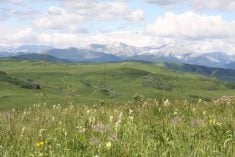CALGARY – When seeding in dry conditions financial risk can be reduced at the
fertilizer bin.
Young plants can be burned by excess fertilizer. Reducing the amount applied now can give crops the chance to use moisture if it arrives later, said Ed Tanner, provincial agrologist at Indian Head, Sask.
Late season application of fertilizers that aren’t needed for early crop establishment allows producers to evaluate post-emergent growing conditions before making a financial commitment.
Tanner said he expects producers will reduce initial fertilizer rates to lower input costs and protect young plants.
Read Also

Gene editing digs deeper space in Canadian plant breeding
More Canadian research into crop variety development is incorporating gene editing, and one researcher notes that Canada’s regulatory approach to gene editing will help drive innovation
“Seeding conditions have been good even if they are dry. Crops will get off to an early start. For those that can make the decision to cut their rates now and apply additional fertilizer later, this could be a good time to do some risk management,” said Tanner.
Guidelines for safe rates of seed-placed fertilizer are based on good to excellent moisture. When seedbed moisture is low or conditions are hot and windy, rates should be reduced by half, said agrologists and fertilizer manufacturers.
“Farmers are going to need to read the fine print this year. Current conditions have been real hard on seedbed moisture. If (producers) are planning to apply (nitrogen) at the high end (of) the recommended seed placed N-rates, then they should consider cutting it down. Especially if there is no rain in the forecast,” said John Heard of Manitoba Agriculture.
Reducing fertilizer at seeding may provide early advantages but agronomists warn if rain does fall, nitrogen will be doubly important.
“If it does begin to rain, farmers will have to get the fertilizer out there on the crop. This is one of those years where you can improve your odds when gambling on the weather,” said Brian Fowler, research scientist with the Crop Development Centre at the University of Saskatchewan.
“If they don’t get enough nitrogen on the fields the pot won’t be very big this year.”
Farmers with winter wheat and others who topdressed fertilizer early may have already suffered losses due to fickle weather. Those who applied nitrogen may have seen that investment blown away by wind.
Hot, dry conditions in many regions have broken down pellets on the surface, hydrolyzing the urea and allowing it to be removed by air rather than being trapped in the soil.
“It appears the losses are in the 30 to 35 percent range. For some it will be more, some less, depending on the area. In general everybody has lost some of their nitrogen,” said Heard.
Effect of heat
He said tests at Brandon showed fertilizer applied to the surface was depleted by 40 percent after seven days with average temperatures of 20 C to 25 C. In averages of 30 C, losses climbed to 88 percent.
Even at temperature averages of 15 C, losses are seven percent, according to University of Manitoba tests.
“There have been significant losses and producers will need to monitor their crops closely for yellowing and other signs of problems caused by a lack of nitrogen.”
If there is visible yellowing or wilting of plants that haven’t been fertilized, top dressing will be necessary. Spreading fertilizer by hand in a small area can give growers an idea of how their crop is responding to lost nitrogen. “It is a good way to make an educated guess on losses due to weather conditions,” Heard said.
“If you can see an obvious difference in the test area, then you can go back with an application of 50 percent of your initial rate. It is bit of gamble, but better to have a good crop that costs a little more than a poor one that doesn’t cover expenses.”














